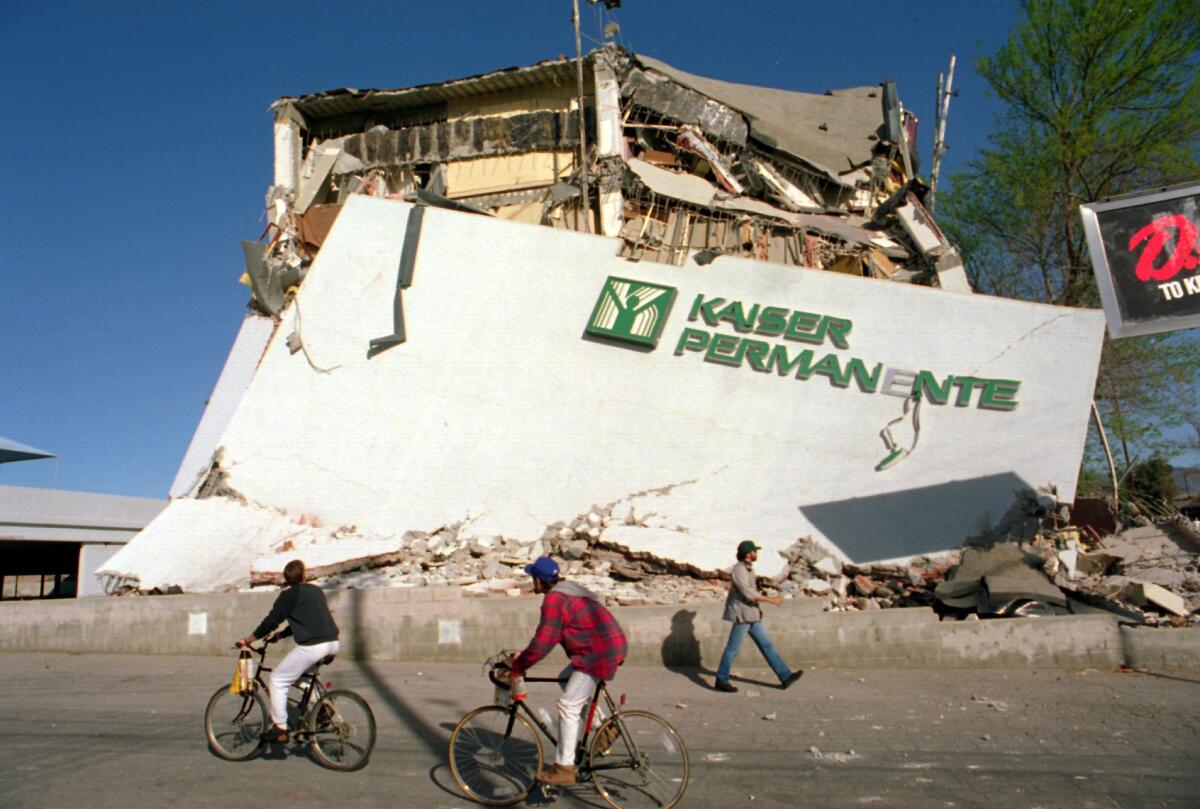Sierra Madre fault map brings new restrictions

- Share via
New earthquake restrictions on development are now in effect across a large swath of the northern San Gabriel Valley after the state released final maps for a section of the Sierra Madre fault zone.
The fault is one of Los Angeles County’s longest, stretching more than 50 miles along the foothills of the San Gabriel Mountains, which were created by earthquake activity.
The fault, which last ruptured more than 8,000 years ago, could produce an earthquake as large as magnitude 7.5.
Under state law, new development is generally prohibited within 50 feet of an active fault. Developers who want to build in this new zone would have to prove that their projects are not above an active fault.
The newly mapped section of the San Gabriel Valley fault crosses through Monrovia, Bradbury, Duarte, Azusa, Irwindale and Glendora.
A draft map of the zone released in January has already sparked changes along the fault’s path.
At Dalton Elementary School in Azusa, students have been ordered out of buildings closest to the fault. At nearby Charles Lee Elementary School, school officials have launched extensive underground radar-like testing, and the studies seemed to agree with the state geologist’s findings about the location of the fault, said Terry Tao, a lawyer for the Azusa Unified School District.
Officials are trying to apply for funding to address the safety risks at Lee and find a way to “not use those buildings for any school purposes,” Tao said.
The fault zone also goes through the site of an elementary school proposed for the master-planned Rosedale community in northern Azusa. Because it would be a public elementary school, the developer would need to prove to the California Geological Survey that classrooms would not be built on an earthquake fault.
“Taking into account all the known seismic information, we believe that the proposed school remains developable as mapped,” said Tim McGarry, spokesman for Rosedale Land Partners.
Two other sections of the fault’s estimated path cross into Rosedale’s northern neighborhood, but those houses were already built to avoid the fault lines later mapped by the state.
A third section of the fault, farther south, was initially mapped as going under several newly built homes. But new data from the developer led the state to agree that this particular fault is inactive and last moved tens of thousands of years ago.
There have been 68 separate trenches dug to locate faults on the Rosedale site over the last two decades, the developer said. The new map will not affect unbuilt portions of Rosedale, McGarry said.
In Glendora, the estimated fault line goes under Citrus College’s 1,400-seat performing arts complex, built more than 40 years ago. A spokeswoman for the college, Paula Green, declined Friday to outline the school’s response to the fault map, but released a statement:
“As a public educational agency, Citrus College obtains all necessary approvals from the California Geological Survey and the Division of the State Architect prior to engaging in any significant construction project,” the statement said. “Citrus College continues to ensure that it is compliant with all DSA building and safety standards.”
Earlier this spring, Patricia Rasmussen, president of the Board of Trustees, said in an interview that the fault’s location was new information to her.
“Anything that involves the college and the safety of the students is the responsibility of the board,” Rasmussen said. “Student safety is our utmost concern.”
California law restricts development on earthquake faults that have ruptured in the last 11,000 years, since the last ice age.
That time frame was chosen because faults that have not moved during that time were probably less likely to rupture in our lifetime, said Tim McCrink, supervising engineering geologist of the state’s seismic hazards program.
But faults more than 11,000 years old can reawaken. That happened in the 7.3 Landers earthquake of 1992 in the Mojave Desert, when a fault that had not moved in perhaps the last 20,000 years ruptured, state senior engineering geologist Jerry Treiman said.
“So technically, legally, they might’ve been called inactive ... but we really can’t say they’re dead,” Treiman said.
The release of this map came Thursday, the same day as the unveiling of the Hollywood fault zone, the most controversial in the history of California’s 42-year-old Alquist-Priolo fault zoning program. State geologist John Parrish said he concluded an active fault ran under the site of a massive proposed skyscraper project, which would be the tallest and largest development in Hollywood history.
“Our conclusion from the data is that there is an active fault,” he said, referring to an eastern section of the Millennium site. “We feel that we can take any challenge to it with the data there. There are very hard points on where that fault is.”
Millennium officials said that their data show there is no active fault under the site and that they will do any additional seismic testing required by the city.
The mapped Hollywood fault zone covers a narrow stretch of land from the Sunset Strip in West Hollywood to Atwater Village. Legally, owners of existing buildings are not required to do anything after the map is issued.
Parrish, however, encouraged private schools and preschools to consider voluntarily researching to see if a fault goes underneath classrooms, as the Los Angeles and Azusa school districts have done. “We’re talking about children here, gathered in large quantities. So I think they should take an active role in studying the area that they are in,” Parrish said.
State officials are next looking at mapping the Santa Monica fault on Los Angeles’ Westside and faults in the northeast Los Angeles area. Mapping is also underway on the West Napa fault, which ruptured in August’s 6.0 earthquake.
rosanna.xia@latimes.com, ron.lin@latimes.com, thomas.lauder@latimes.com
Twitter: @RosannaXia, @ronlin, @thomas06037
More to Read
Sign up for Essential California
The most important California stories and recommendations in your inbox every morning.
You may occasionally receive promotional content from the Los Angeles Times.













